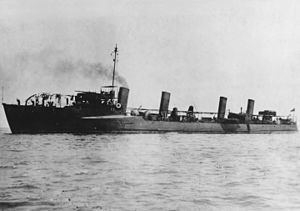Name Chauncey Awarded 1 October 1898 Construction started 2 December 1899 Length 76 m | Ordered 4 May 1898 Laid down 2 December 1899 Launched 26 October 1901 Builder Neafie & Levy | |
 | ||
Cost $283,000 (hull and machinery) | ||
The first USS Chauncey (Destroyer No. 3/DD-3) was a Bainbridge-class destroyer, also referred to as a "Torpedo-boat destroyer", in the United States Navy named for Commodore Isaac Chauncey. She was launched in 1901 and sunk in 1917.
Contents
Construction and design
Chauncey was laid down at Neafie and Levy Ship and Engine Building Company of Philadelphia, Pennsylvania on 2 December 1899 as a member of the Bainbridge class, and was launched on 26 October 1901.
Chauncey was 249 ft 9 7⁄8 in (76.15 m) long overall and 244 ft 2 7⁄8 in (74.44 m) at the waterline, with a beam of 23 ft 5 in (7.14 m) and a draft of 6 ft 6 in (1.98 m). As the Bainbridge class was intended to be more seaworthy than the US Navy's torpedo boats, the ship had a raised forecastle instead of the "turtleback" forecastle common in European designs. Design displacement was 420 long tons (430 t) and 631 long tons (641 t) full load, although all ships of the class were overweight. Four Thornycroft boilers fed steam at 250 psi (1,700 kPa) to triple expansion steam engines rated at 8,000 ihp (6,000 kW) driving two shafts for a design speed of 28 kn (52 km/h; 32 mph). Four funnels were fitted. Armament consisted of two 3-inch (76 mm)/50 caliber guns, five 6-pounder (57 millimetres (2.2 in)) guns and two 18-inch (457 mm) torpedo tubes.
Chauncey was placed in reduced commission on 20 November 1902, then placed in reserve on 2 December 1902 and received full commission on 21 February 1903. Lieutenant Stanford Elwood Moses was placed in command and Chauncey reported to the Atlantic Fleet.
Pre-World War I
Chauncey served with the Coast Squadron until 20 September 1903, when she was transferred to the Asiatic Fleet and left Key West for the Orient on 18 December. After sailing by way of the Suez Canal, she arrived at Cavite to join the force representing US interest in the Far East as it cruised in the Philippines during winters and off China during summers. Aside from the period of 3 December 1905 – 12 January 1907, when she was in reserve at Cavite, Chauncey continued this service until the entrance of America into World War I.
Sinking
The destroyer sailed from Cavite on 1 August 1917 for convoy escort duty in the eastern Atlantic, based at St. Nazaire, France. On 19 November, while about 110 mi (180 km) west of Gibraltar on escort duty, Chauncey was rammed by the British merchantman SS Rose as both ships steamed in war-imposed darkness. At 03:17, Chauncey sank in 1,500 fathoms (9,000 ft; 2,700 m) of water, taking to their death 21 men including her captain, Lieutenant Commander Walter E. Reno, the namesake of the Clemson-class destroyer Reno, and LTJG Charles F. Wedderburn, the namesake of the Fletcher-class destroyer Wedderburn. Seventy survivors were picked up by Rose, and carried to port.
Chauncey in literature
The novel Delilah was written by a survivor of Chauncey, Marcus Goodrich, and is a fictional account based on his experience serving aboard Chauncey as an enlisted man.
